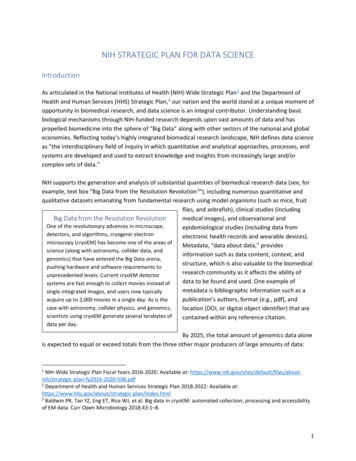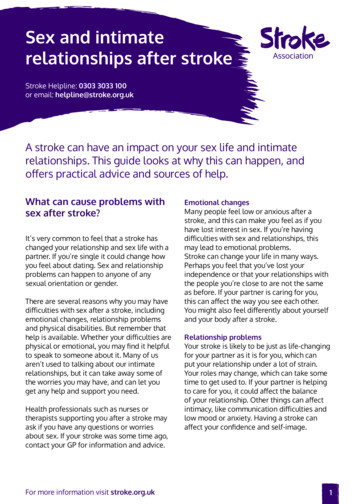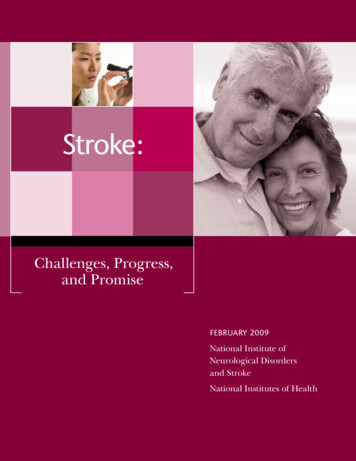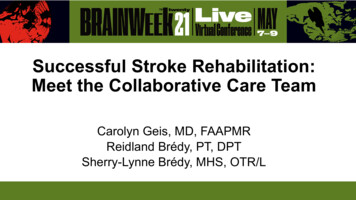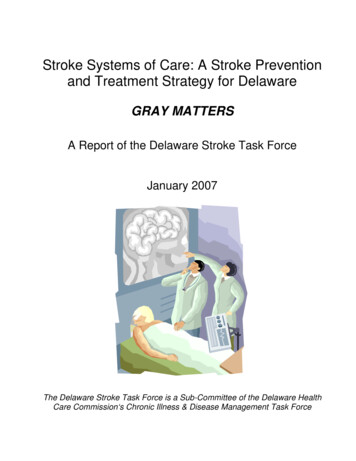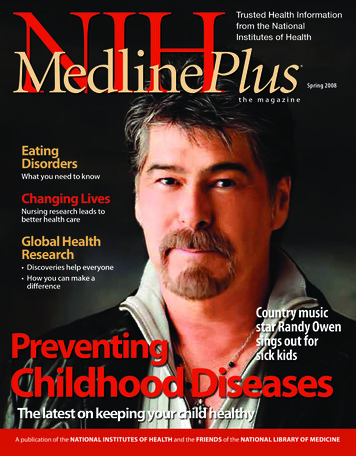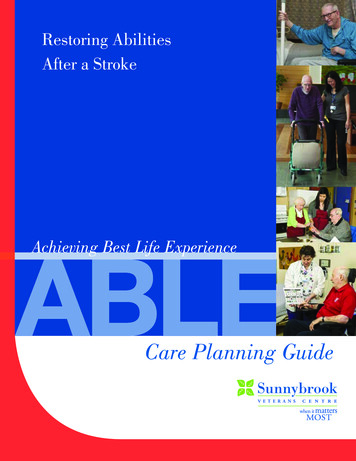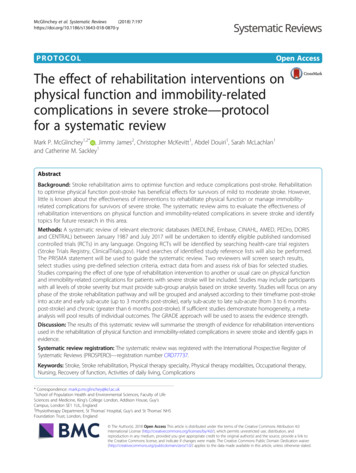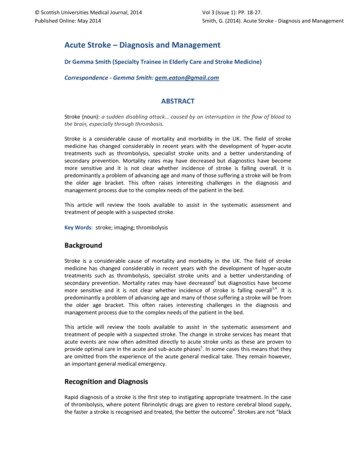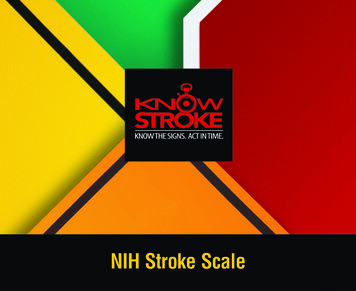
Transcription
NIH Stroke Scale
InstructionsAdminister stroke scale items in theorder listed. Record performance ineach category after each subscale exam.Do not go back and change scores.Follow directions provided for eachexam technique. Scores should reflectwhat the patient does, not what theclinician thinks the patient can do.The clinician should record answers whileadministering the exam and work quickly.Except where indicated, the patientshould not be coached (i.e., repeatedrequests to patient to make aspecial effort).1aInstructionsLevel of Consciousness:The investigator must choose a responseif a full evaluation is prevented by suchobstacles as an endotracheal tube, languagebarrier, orotracheal trauma/bandages. A 3 isscored only if the patient makes no movement(other than reflexive posturing) in response tonoxious stimulation.Level of Consciousness01Scale DefinitionAlert; keenly responsive.Not alert; but arousable by minorstimulation to obey, answer,or respond.2Not alert; requires repeatedstimulation to attend, or isobtunded and requires strongor painful stimulation to makemovements (not stereotyped).3Responds only with reflex motoror autonomic effects, or totallyunresponsive, flaccid, and areflexic.Score
Level of ConsciousnessInstructionsLOC Questions:The patient is asked the month and his/herage. The answer must be correct — there isno partial credit for being close. Aphasic andstuporous patients who do not comprehendthe questions will score 2. Patients unableto speak because of endotracheal intubation,orotracheal trauma, severe dysarthria from anycause, language barrier, or any other problemnot secondary to aphasia are given a 1. Itis important that only the initial answer begraded and that the examiner not “help” thepatient with verbal or non-verbal cues.01b1cScale DefinitionInstructionsAnswers both questions correctly.LOC Commands:1Answers one question correctly.2Answers neither question correctly.ScoreThe patient is asked to open and closethe eyes and then to grip and releasethe non-paretic hand. Substituteanother one-step command if the handscannot be used. Credit is given if anunequivocal attempt is made but notcompleted due to weakness. If thepatient does not respond to command,the task should be demonstrated tohim or her (pantomime), and the result scored(i.e., follows none, one, or two commands).Patients with trauma, amputation, orother physical impediments should begiven suitable one-step commands.Only the first attempt is scored.Level of Consciousness0Scale DefinitionPerforms both tasks correctly.1Performs one task correctly.2Performs neither task correctly.Score
Best GazeInstructionsBest Gaze:Only horizontal eye movements will be tested.Voluntary or reflexive (oculocephalic) eyemovements will be scored, but caloric testingis not done. If the patient has a conjugatedeviation of the eyes that can be overcomeby voluntary or reflexive activity, the scorewill be 1. If a patient has an isolatedperipheral nerve paresis (CN III, IV, or VI),score a 1. Gaze is testable in all aphasicpatients. Patients with ocular trauma,bandages, pre-existing blindness, or otherdisorder of visual acuity or fields should betested with reflexive movements, and a choicemade by the investigator. Establishing eyecontact and then moving about the patientfrom side to side will occasionally clarify thepresence of a partial gaze palsy.01223Scale DefinitionInstructionsNormal.Visual:Partial gaze palsy; gaze is abnormalin one or both eyes, but forceddeviation or total gaze paresis isnot present.Forced deviation, or totalgaze paresis is not overcome by theoculocephalic maneuver.ScoreVisual fields (upper and lower quadrants) aretested by confrontation, using finger countingor visual threat, as appropriate. Patients maybe encouraged, but if they look at the side ofthe moving fingers appropriately, this canbe scored as normal. If there is unilateralblindness or enucleation, visual fields in theremaining eye are scored. Score 1 only if aclear-cut asymmetry, including quadrantanopia,is found. If patient is blind from any cause,score 3. Double simultaneous stimulation isperformed at this point. If there is extinction,patient receives a 1, and the resultsare used to respond to item 11.Visual0Scale DefinitionNo visual loss.1Partial hemianopia.2Complete hemianopia.3Bilateral hemianopia (blind includingcortical blindness).Score
Facial PalsyInstructionsFacial Palsy:Ask — or use pantomime to encourage — thepatient to show teeth or raise eyebrows andclose eyes. Score symmetry of grimace inresponse to noxious stimuli in the poorlyresponsive or non-comprehending patient.If facial trauma/bandages, orotracheal tube,tape, or other physical barriers obscurethe face, these should be removed to theextent possible.045Scale DefinitionInstructionsNormal symmetrical movements.Motor Arm:1Minor paralysis (flattened nasolabialfold, asymmetry on smiling).2Partial paralysis (total or near-totalparalysis of lower face).3Complete paralysis of one or bothsides (absence of facial movement inthe upper and lower face).ScoreMotor ArmScale DefinitionThe limb is placed in the appropriate position:extend the arms (palms down) 90 degrees(if sitting) or 45 degrees (if supine). Drift isscored if the arm falls before 10 seconds. Theaphasic patient is encouraged using urgencyin the voice and pantomime, but not noxiousstimulation. Each limb is tested in turn,beginning with the non-paretic arm. Onlyin the case of amputation or joint fusion atthe shoulder, the examiner should record thescore as untestable (UN) and clearly write theexplanation for this choice.a5b5Left ArmRight ArmScoreScore01234UNNo drift; limb holds 90 (or 45) degreesfor full 10 seconds.Drift; limb holds 90 (or 45) degrees,but drifts down before full 10 seconds;does not hit bed or other support.Some effort against gravity; limbcannot get to or maintain (if cued) 90(or 45) degrees, drifts down to bed,but has some effort against gravity.No effort against gravity; limb falls.No movement.Amputation or joint fusion, explain:
Motor LegInstructionsMotor Leg:The limb is placed in the appropriate position:hold the leg at 30 degrees (always testedsupine). Drift is scored if the leg falls before5 seconds. The aphasic patient is encouragedusing urgency in the voice and pantomime butnot noxious stimulation. Each limb is testedin turn, beginning with the non-paretic leg.Only in the case of amputation or joint fusionat the hip, the examiner should record thescore as untestable (UN) and clearly write theexplanation for this choice.a6b6Left LegRight LegScoreScore01234UN67Scale DefinitionInstructionsNo drift; leg holds 30-degree positionfor full 5 seconds.Limb Ataxia:Drift; leg falls by the end of the 5second period but does not hit the bed.Some effort against gravity; leg fallsto bed by 5 seconds but has someeffort against gravity.No effort against gravity; leg falls tobed immediately.No movement.Amputation or joint fusion, explain:This item is aimed at finding evidence of aunilateral cerebellar lesion. Test with eyesopen. In case of visual defect, ensure testingis done in intact visual field. The fingernose-finger and heel-shin tests are performedon both sides, and ataxia is scored only ifpresent out of proportion to weakness. Ataxiais absent in the patient who cannot understand or is paralyzed. Only in the case ofamputation or joint fusion, the examinershould record the score as untestable (UN)and clearly write the explanation for thischoice. In case of blindness, test by havingthe patient touch nose from extended armposition.Limb Ataxia0Scale DefinitionAbsent.1Present in one limb.2Present in two limbs.UNAmputation or joint fusion, explain:Score
SensoryInstructionsSensory:Sensation or grimace to pinprick when tested,or withdrawal from noxious stimulus in theobtunded or aphasic patient. Only sensoryloss attributed to stroke is scored as abnormaland the examiner should test as many bodyareas [arms (not hands), legs, trunk, face]as needed to accurately check for hemisensoryloss. A score of 2, “severe or total sensoryloss,” should only be given when a severeor total loss of sensation can be clearlydemonstrated. Stuporous and aphasic patientswill, therefore, probably score 1 or 0. Thepatient with brainstem stroke who has bilateralloss of sensation is scored 2. If the patientdoes not respond and is quadriplegic, score 2.Patients in a coma (item 1a 3) are automatically given a 2 on this item.01289Scale DefinitionInstructionsNormal; no sensory loss.Best Language:Mild-to-moderate sensory loss;patient feels pinprick is less sharpor is dull on the affected side; orthere is a loss of superficial painwith pinprick, but patient is awareof being touched.Severe or total sensory loss; patientis not aware of being touched in theface, arm, and leg.ScoreA great deal of information aboutcomprehension will be obtained during thepreceding sections of the examination. Forthis scale item, the patient is asked todescribe what is happening in the attachedpicture, to name the items on the attachednaming sheet, and to read from the attachedlist of sentences. Comprehension is judgedfrom responses here, as well as to all of thecommands in the preceding general neurologicalexam. If visual loss interferes with the tests,ask the patient to identify objects placed inthe hand, repeat, and produce speech. Theintubated patient should be asked to write.The patient in a coma (item 1a 3) willautomatically score 3 on this item. The examinermust choose a score for the patient with stuporor limited cooperation, but a score of 3 shouldbe used only if the patient is mute and followsno one-step commands.Best Language0Scale DefinitionNo aphasia; normal.1Mild-to-moderate aphasia; some obviousloss of fluency or facility of comprehension,without significant limitation on ideasexpressed or form of expression. Reductionof speech and/or comprehension, however,makes conversation about provided materialsdifficult or impossible. For example, inconversation about provided materials,examiner can identify picture or naming cardcontent from patient’s response.2Severe aphasia; all communication isthrough fragmentary expression; great needfor inference, questioning, and guessing bythe listener. Range of information that canbe exchanged is limited; listener carriesburden of communication. Examiner cannotidentify materials provided from patientresponse.3Mute, global aphasia; no usable speechor auditory comprehension.Score
DysarthriaInstructionsDysarthria:If patient is thought to be normal, anadequate sample of speech must be obtainedby asking patient to read or repeat words fromthe attached list. If the patient has severeaphasia, the clarity of articulation ofspontaneous speech can be rated. Only if thepatient is intubated or has other physicalbarriers to producing speech, the examinershould record the score as untestable (UN) andclearly write the explanation for this choice.Do not tell the patient why he/she is beingtested.012UN1011Scale DefinitionInstructionsNormal.Extinction and Inattention (formerly Neglect):Mild-to-moderate dysarthria;patient slurs at least some wordsand, at worst, can be understoodwith some difficulty.Severe dysarthria; patient’s speechis so slurred as to be unintelligiblein the absence of or out ofproportion to any dysphasia, or ismute/anarthric.Sufficient information to identify neglect maybe obtained during the prior testing. If thepatient has a severe visual loss preventingvisual double simultaneous stimulation, andthe cutaneous stimuli are normal, the score isnormal. If the patient has aphasia but doesappear to attend to both sides, the score isnormal. The presence of visual spatial neglector anosagnosia may also be taken as evidenceof abnormality. Since the abnormality isscored only if present, the item is neveruntestable.Extinction and Inattention0Scale DefinitionNo abnormality.1Visual, tactile, auditory, spatial, orpersonal inattention, or extinction tobilateral simultaneous stimulation inone of the sensory modalities.2Profound hemi-inattention or extinctionto more than one modality; does notrecognize own hand or orients to only oneside of space.Intubated or other physical barrier,explain:ScoreScore
You know how.MAMADown to earth.TIP – TOPI got home from work.FIFTY – FIFTYNear the table in the dining room.THANKSThey heard him speak on theradio last night.HUCKLEBERRYBASEBALL PLAYER
www.ninds.nih.gov1-800-352-9424
the attached list. If the patient has severe aphasia, the clarity of articulation of spontaneous speech can be rated. Only if the patient is intubated or has other physical barriers to producing speech, the examiner should record the score as untestable (UN) and clearly write the explanation for this choice. Do not tell the patient why he/she .File Size: 1MB
